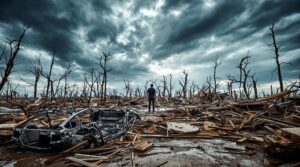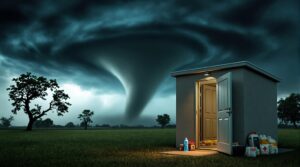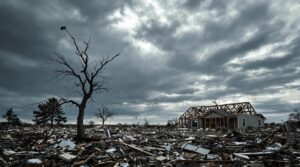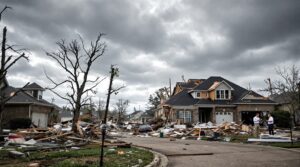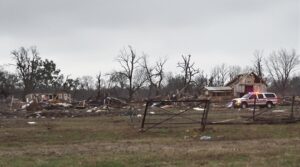Effective tornado preparation requires establishing a thorough emergency plan and identifying a safe room, preferably a basement or interior windowless space on the lowest floor. Families should maintain a well-stocked emergency kit with water, non-perishable food, batteries, flashlights, and a NOAA weather radio. Regular drills help reinforce evacuation procedures and safety protocols. Teaching children about weather conditions and safety measures guarantees all household members understand their roles. The following guidelines provide essential details for maximizing household safety during severe weather events. In addition to preparing an emergency plan and kit, families can enhance their safety by investing in tornado resistant construction techniques for their homes. This may include reinforcing walls, installing storm shutters, and using impact-resistant windows to minimize damage during a tornado. Staying informed about local weather updates through mobile applications and community alerts can further ensure that families are ready to act quickly when severe weather strikes.
Key Takeaways
- Designate a safe room in your basement or an interior room on the lowest floor away from windows and exterior walls.
- Create an emergency supply kit with water, nonperishable food, medications, flashlights, batteries, and important documents in waterproof containers.
- Install a NOAA Weather Radio and enable local emergency alerts on phones to receive immediate tornado warnings.
- Practice your family tornado emergency plan regularly, including evacuation routes and communication procedures with all household members.
- Secure outdoor items that could become projectiles and maintain trees and branches near your home to prevent storm damage.
Creating Your Family's Tornado Emergency Plan
Creating a thorough family tornado emergency plan involves four essential components: identifying safe locations, establishing communication protocols, preparing for weather alerts, and addressing specific family needs.
Families should first designate a safe room in their home, preferably a basement, storm cellar, or windowless interior room on the lowest floor. Each family member must understand their roles during an emergency and know the evacuation routes from both home and workplace.
Communication tools, including NOAA Weather Radio and local alert systems, should be established to guarantee timely warnings. The plan should include emergency contact numbers, an out-of-town contact person, and a designated family meeting point.
Regular drills help reinforce these procedures and identify any gaps in preparation. Special considerations must address family members with specific needs, pets, and the storage of vital documents.
Families should also maintain a list of utility shutoff locations and make sure all members know how to access emergency supplies.
Setting Up a Well-Stocked Storm Safety Kit
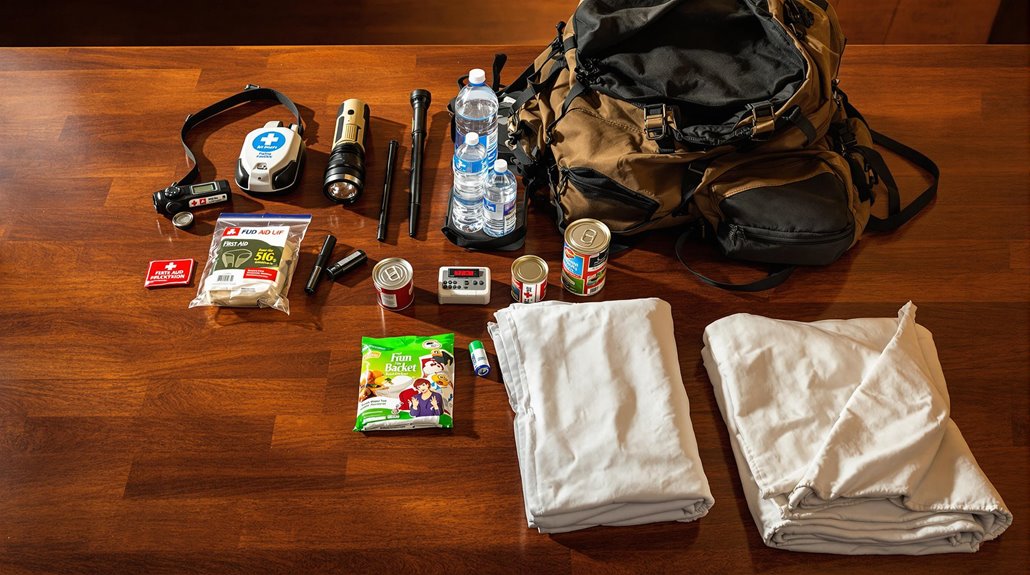
An adequately stocked storm safety kit serves as an essential lifeline during and after a tornado emergency.
The kit should contain sufficient water, allocating one gallon per person daily for at least three days, along with nonperishable food items and necessary preparation tools.
Storm supplies should include extensive shelter materials, such as blankets, tarps, and protective clothing for each family member.
Kit organization should prioritize first aid supplies, prescription medications, and essential hygiene items stored in easily accessible containers.
A well-prepared kit must contain communication devices like weather radios, flashlights with extra batteries, and fully charged cell phones with backup power sources.
Important documents should be stored in waterproof containers, accompanied by local maps for navigation.
Special consideration must be given to specific needs, including infant supplies, pet necessities, and medical equipment such as glasses or hearing aids, ensuring the kit addresses the unique requirements of every household member.
Identifying the Safest Spots in Your Home
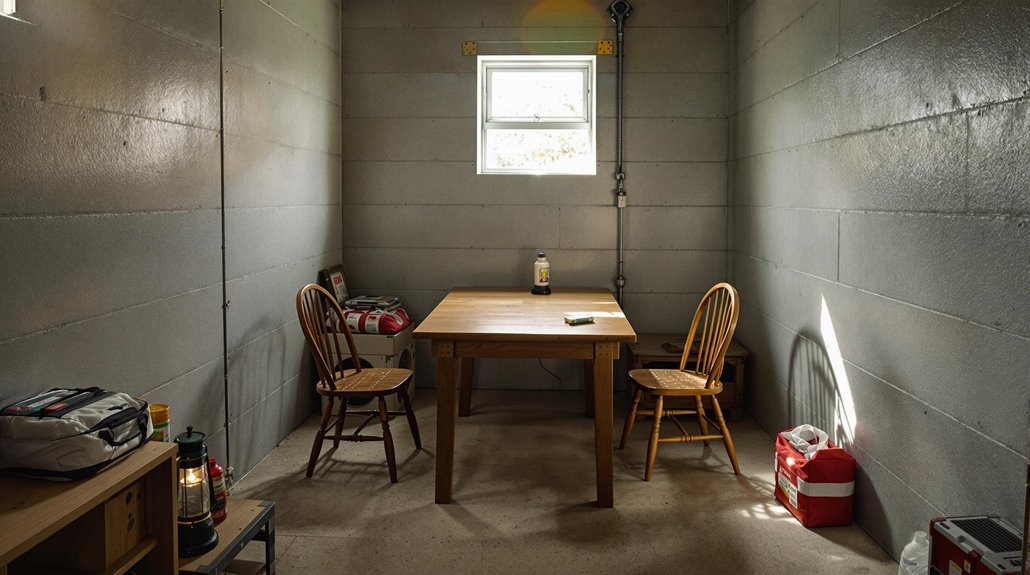
When a tornado threatens, the location chosen within a home can mean the difference between life and death. Safe room selection should prioritize interior spaces on the lowest level of the structure, with basements being the best choice.
If a basement is unavailable, residents should identify an interior room without windows on the ground floor. Interior bathrooms, closets, and center hallways often serve as effective shelter locations due to their structural reinforcement and lack of exterior exposure.
The space beneath a stairwell can provide additional protection from debris. During tornado safety drills, families should practice accessing these designated safe spots quickly and efficiently.
Special considerations apply to different housing types. Mobile home residents must plan to evacuate to a sturdier structure, while apartment dwellers should identify interior spaces on lower floors.
In all cases, occupants should protect themselves with sturdy furniture, mattresses, or blankets while sheltering in their chosen location.
Teaching Children About Tornado Safety

Teaching children proper tornado safety measures requires both careful planning and age-appropriate instruction. Parents and caregivers should focus on dispelling common tornado myths while creating kid-friendly activities that reinforce safety protocols. This includes conducting regular drills, reviewing warning signs, and maintaining a positive, calm atmosphere during discussions about severe weather.
Essential components for teaching tornado safety to children include:
- Visual learning aids and interactive demonstrations to help identify threatening weather conditions
- Regular practice sessions of the family emergency plan, including evacuation routes and safe room locations
- Age-appropriate discussions about post-tornado recovery and cleanup participation
Children should be actively involved in preparing emergency supply kits and understanding their contents. Incorporating games and activities during preparation helps reduce anxiety while building confidence in safety procedures.
Parents should also coordinate with schools and daycare facilities to guarantee consistency in emergency protocols and maintain open communication about disaster preparedness strategies.
Essential Steps During a Tornado Warning
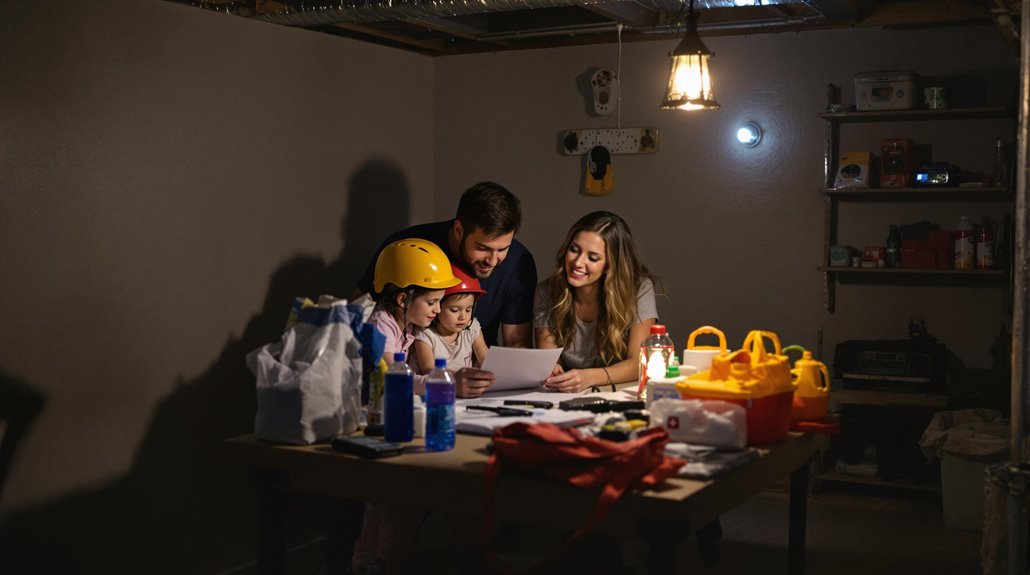
Responding swiftly and correctly to a tornado warning can mean the difference between life and death. A thorough tornado preparedness checklist emphasizes seeking immediate shelter in pre-designated safe areas, preferably in a basement or the lowest building level. Storm safety education highlights the importance of putting maximum barriers between occupants and the outdoors.
| Action | Location | Safety Measure |
|---|---|---|
| Seek Shelter | Basement/Lower Level | Get under sturdy table |
| Protect Body | Interior Room | Cover head and neck |
| Avoid Areas | Windows/Doors | Stay away from glass |
| Monitor Updates | Safe Location | Use NOAA radio |
| Follow Protocol | Throughout Home | Turn off utilities |
If caught outside during a warning, individuals should avoid seeking shelter under bridges or overpasses. Instead, lying flat in a nearby ditch away from trees represents the safest option, while remaining alert to potential flooding. Maintaining access to weather updates through a NOAA Weather Radio provides critical information throughout the emergency.
The Benefits Of Consulting A Public Adjuster

When dealing with tornado damage claims, consulting a public adjuster provides professional expertise in traversing complex insurance policies and maximizing claim settlements.
A qualified public adjuster offers an unbiased assessment of property damage while managing all documentation and negotiations with insurance companies.
Their involvement often results in higher claim payouts and a more efficient claims process, allowing homeowners to focus on recovery rather than paperwork.
Studies show that claims handled by public adjuster services can receive settlements up to 500% higher for non-catastrophic events compared to those without professional representation.
Expertise In Insurance Claims
Insurance claims following a tornado can be complex and overwhelming, making the expertise of a public adjuster invaluable.
These professionals possess specialized knowledge of policy coverage and understand the intricate details of the claims process. Their expertise enables them to identify all potential damages and guarantee proper documentation for maximum settlement value.
- Public adjusters typically secure settlements that are markedly higher than those obtained by policyholders alone, with average increases of up to 574%.
- They handle all aspects of claim management, from initial filing through final settlement negotiations.
- Working on a contingency basis, public adjusters charge a percentage of the settlement, typically 10% for initial claims, assuring their interests align with maximizing the policyholder's recovery.
Their extensive understanding of local insurance laws and policy enforcement makes them essential advocates during post-tornado recovery.
A POLICYHOLDER FIRST commitment ensures that qualified public adjusters maintain clear communication and prioritize client interests throughout the claims process.
Objective Damage Assessment
Professional damage assessment conducted by public adjusters provides property owners with an objective and complete evaluation of tornado destruction.
Using specialized equipment like infrared cameras and drones, adjusters identify both visible and hidden damage that might otherwise go unnoticed.
This complete damage assessment forms the foundation for accurate claim preparation. Public adjusters utilize forensic analysis and detailed documentation to build strong cases for insurance claims.
Their impartial perspective guarantees that all damages are properly cataloged, from structural issues to moisture-related problems.
The objective representation provided by public adjusters helps maximize settlement outcomes through professional negotiation with insurance companies.
Their expertise prevents knowledge gaps from being exploited and guarantees property owners receive fair compensation based on thorough documentation and evidence-based assessments.
Unlike insurance adjusters who represent company interests, public adjusters work on a commission-based fee that aligns their goals with maximizing client settlements.
Streamlined Claim Process
Partnering with a public adjuster dramatically streamlines the tornado insurance claim process through automated workflows and expert guidance. Their specialized systems minimize errors while accelerating document processing and data entry, ensuring accurate settlement calculations.
This automated workflow reduces processing times and enhances the overall efficiency of claims handling.
Public adjusters operate on contingency fee basis, typically charging 5-20% of the final settlement amount.
Key benefits of working with a public adjuster include:
- Automated document creation and data verification that considerably reduces manual errors and processing delays
- Real-time communication channels that enable swift collaboration between all parties involved
- Self-service options that provide policyholders with transparent access to claim status and documentation
This streamlined claims approach not only expedites the settlement process but also provides cost-effective solutions through reduced administrative overhead and improved accuracy in damage assessment documentation.
Higher Claim Payouts & Settlements
When homeowners collaborate with public adjusters following a tornado, they typically receive considerably higher claim settlements compared to filing independently. This is primarily due to the adjuster's expertise in extensive damage assessment and thorough claim documentation.
Public adjusters employ proven negotiation strategies to maximize settlements, leveraging their in-depth understanding of insurance policies and procedures. They meticulously identify all damages, including those that might be overlooked by property owners, and guarantee proper valuation of losses.
Working on a contingency basis of up to 10% of the settlement, adjusters are motivated to secure the highest possible payout. Their professional expertise in interpreting policy fine print and countering insurance company tactics often results in settlements that greatly exceed what homeowners might obtain on their own. With annual earnings between $60,000 to $200,000, public adjusters demonstrate their value through consistently successful claim resolutions.
About The Public Claims Adjusters Network (PCAN)
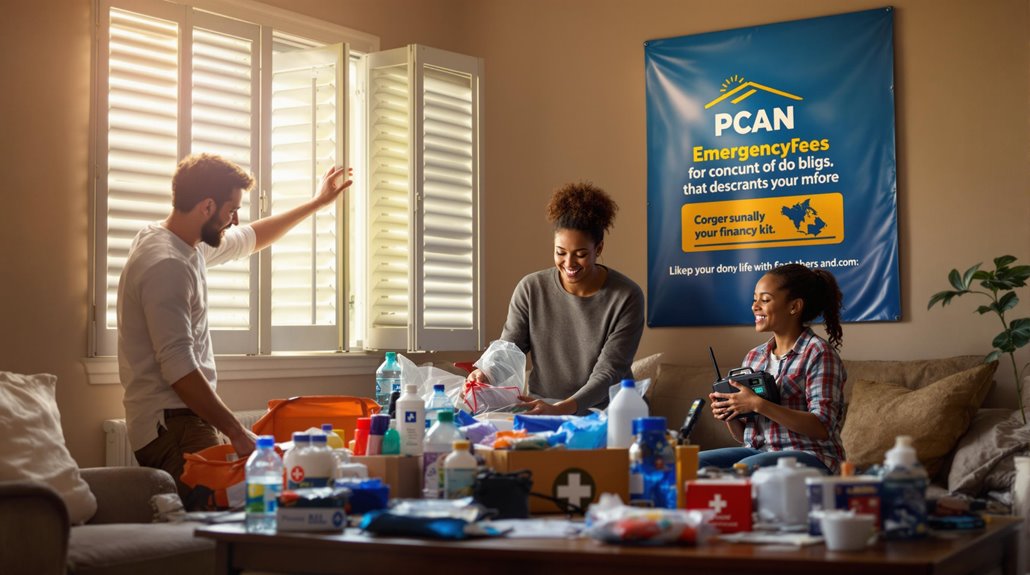
Though public claims adjusters play an essential role in post-disaster recovery, this section about PCAN should be replaced with more relevant information about tornado preparation and safety measures.
While understanding public adjuster roles and insurance claim strategies may be valuable after a disaster, immediate safety preparations take precedence when discussing tornado readiness.
To maintain focus on tornado preparedness, consider these critical safety elements instead:
- Creating a thorough household emergency plan with designated shelter areas and family communication protocols
- Establishing a well-stocked emergency kit containing essential supplies, medications, and important documents
- Installing weather monitoring systems and maintaining multiple communication channels for emergency alerts
The discussion of public claims adjusters, while important for post-disaster recovery, diverts attention from critical safety measures needed before and during a tornado.
Resources should prioritize protective actions, structural reinforcement, and evacuation procedures to guarantee household safety during severe weather events.
Frequently Asked Questions
How Do Tornadoes Form and What Causes Them to Become Destructive?
Tornado formation occurs when warm rising air meets cool air in unstable conditions, creating rotating thunderstorms. When concentrated into narrow columns, these rotations produce destructive winds capable of devastating communities.
Can Pets Sense an Approaching Tornado Before Humans Can?
Yes, pets can detect approaching tornadoes through their heightened senses, detecting barometric pressure changes, static electricity, and vibrations. Pet behavior and storm responses often include anxiety, hiding, and alerting owners.
What Is the Average Warning Time Before a Tornado Strikes?
Warning systems provide a critical 13-19 minute average lead time before tornado impact, though times vary based on tornado sequence. Modern tornado prediction models help maximize this essential survival window.
How Long Should Families Expect to Stay in Their Shelter Space?
Families should prepare shelter supplies for a minimum three-day stay, though actual duration varies based on tornado severity. Remaining sheltered until authorities declare safety is essential for family readiness.
Do Tornado Shelters Need Ventilation Systems to Be Considered Safe?
Proper shelter design requires robust ventilation systems. Safety standards mandate specific airflow management requirements, including 2 square inches of venting per occupant and strategic placement of openings to guarantee occupant survival.
References
- https://www.kansastag.gov/385/Tornado-Safety-for-Citizens
- https://www.familysafeshelters.com/uncategorized/warning-signs-that-a-tornado-may-develop/
- http://stories.kera.org/tornadochecklist/
- https://writepaper.com/blog/guide-on-tornado-essay-causes-effects-and-dangers
- https://www.cdc.gov/tornadoes/safety/index.html
- https://texasready.gov/make-a-plan/
- https://springfieldmo.macaronikid.com/articles/662d94acb70f91193a0b1fac/be-storm-ready-a-parents-guide-to-tornado-preparedness
- https://www.battlbox.com/blogs/outdoors/crafting-an-effective-tornado-emergency-plan
- https://www.ready.gov/plan
- https://home.howstuffworks.com/home-improvement/household-safety/10-must-haves-storm-survival-kit.htm

